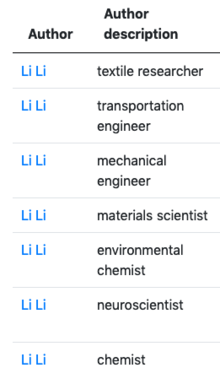Author name disambiguation

Author name disambiguation is a type of
An editor may apply the process to scholarly documents where the goal is to find all mentions of the same author and cluster them together. Authors of scholarly documents often share names which makes it hard to distinguish each author's work. Hence, author name disambiguation aims to find all publications that belong to a given author and distinguish them from publications of other authors who share the same name.
Methods
Considerable research has been conducted into name disambiguation.[1][2][3][4] Typical approaches for author name disambiguation rely on information to distinguish between authors, including (but not limited to) information about the authors such as: their name representation, affiliations and email addresses, and information about the publication: such as year of publication, co-authors, and the topic of the paper. This information can be used to train a machine learning classifier to decide whether two author mentions refer to the same author or not.[5] Much research regards name disambiguation as a clustering problem, i.e., partitioning documents into clusters, where each represents an author.[1][6][7] Other research treats it as a classification problem.[8] Some works constructs a document graph and utilizes the graph topology to learn document similarity.[7][9] Recently, several pieces of research[9][10] aim to learn low-dimensional document representations by employing network embedding methods.[11][12]
Applications

There are multiple reasons that cause author names to be ambiguous, among which: individuals may publish under multiple names for a variety of reasons including different transliteration, misspelling, name change due to marriage, or the use of nicknames or middle names and initials.[13]
Motivations for disambiguating individuals include identifying inventors from patents, and researchers across differing publishers, research insitutions and time periods.[14] Name disambiguation is also a cornerstone in author-centric academic search and mining systems, such as AMiner (formerly ArnetMiner).[15]
Similar issues
Author name disambiguation is only one record linkage problem in the scholarly data domain. Closely related, and potentially mutually beneficial problems include: organisation (affiliation) disambiguation,[16] as well as conference or publication venue disambiguation, since data publishers often use different names or aliases for these entities.
Resources
Several well-known benchmarks to evaluate author name disambiguation are listed below, each of which provides publications with some ambiguous names and their ground truths.
- AMiner name disambiguation dataset
- CiteSeerX name disambiguation dataset
- Semantic Scholar Author Name Disambiguation (S2AND) dataset[17]
Source Codes
References
- ^ S2CID 14068285.
- S2CID 29759924.
- S2CID 1089260.
- S2CID 14132755.
- .
- S2CID 1032074.
- ^ ISBN 978-1-4577-2075-8.
- ISBN 978-3-031-16801-7.
- ^ a b c Yutao Zhang; Fanjin Zhang; Peiran Yao; Jie Tang (2018). Name Disambiguation in AMiner: Clustering, Maintenance, and Human in the Loop. Proceedings of the 24th ACM SIGKDD International Conference on Knowledge Discovery and Data Mining. London: ACM. pp. 1002–1011.
- ^ Baichuan Zhang; Mohammad Al Hasan (2017). Name disambiguation in anonymized graphs using network embedding. Proceedings of the 2017 ACM on Conference on Information and Knowledge Management. Singapore: ACM. pp. 1239–1248.
- ^ Bryan Perozzi; Rami Al-Rfou; Steven Skiena (2014). Deepwalk: Online learning of social representations. Proceedings of the 20th ACM SIGKDD International Conference on Knowledge Discovery and Data Mining. New York: ACM. pp. 701–710.
- ^ Jiezhong Qiu; Yuxiao Dong; Hao Ma; Jian Li; Kuansan Wang; Jie Tang (2018). Network Embedding as Matrix Factorization: Unifying DeepWalk, LINE, PTE, and node2vec. Proceedings of the Eleventh ACM International Conference on Web Search and Data Mining. Marina Del Rey: ACM. pp. 459–467.
- .
- PMID 28509897.
- ^ Jie Tang; Jing Zhang; Limin Yao; Juanzi Li; Li Zhang; Zhong Su (2008). ArnetMiner: extraction and mining of academic social networks. Proceedings of the 14th ACM SIGKDD International Conference on Knowledge Discovery and Data Mining. New York: ACM. pp. 990–998.
- .
- arXiv:2103.07534 [cs.DL].
